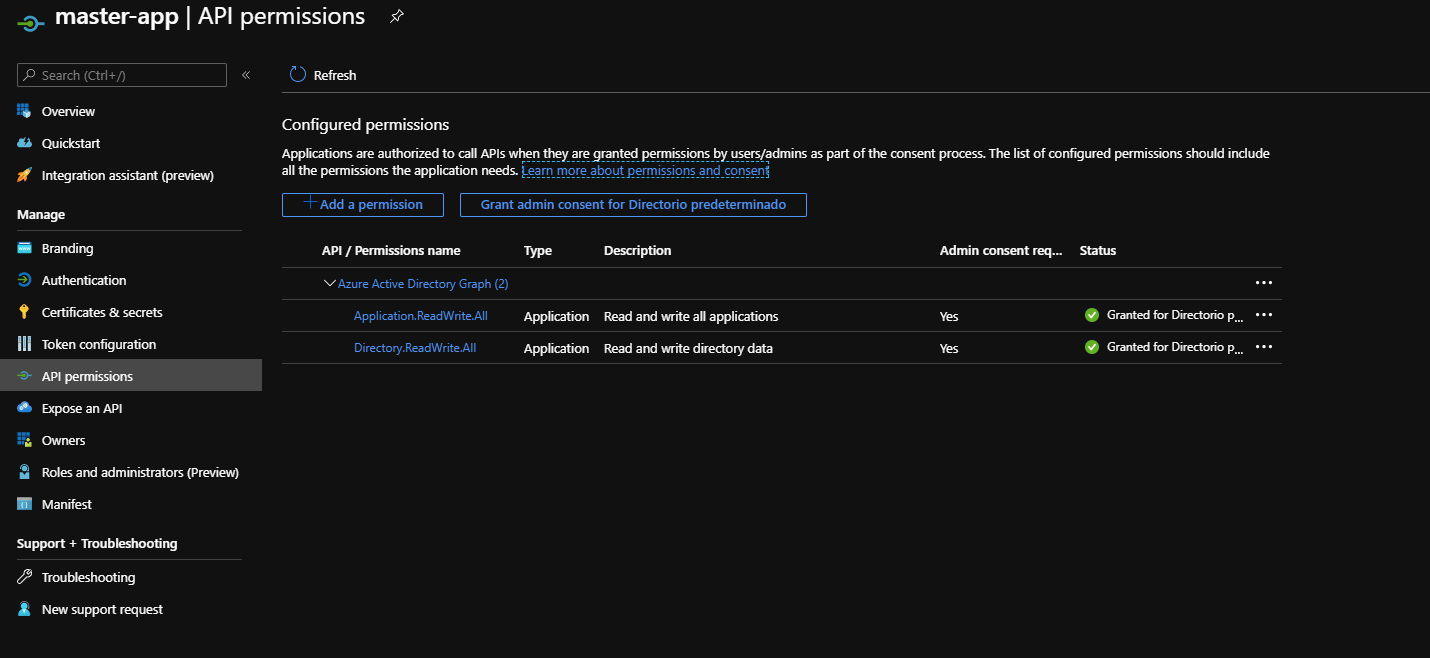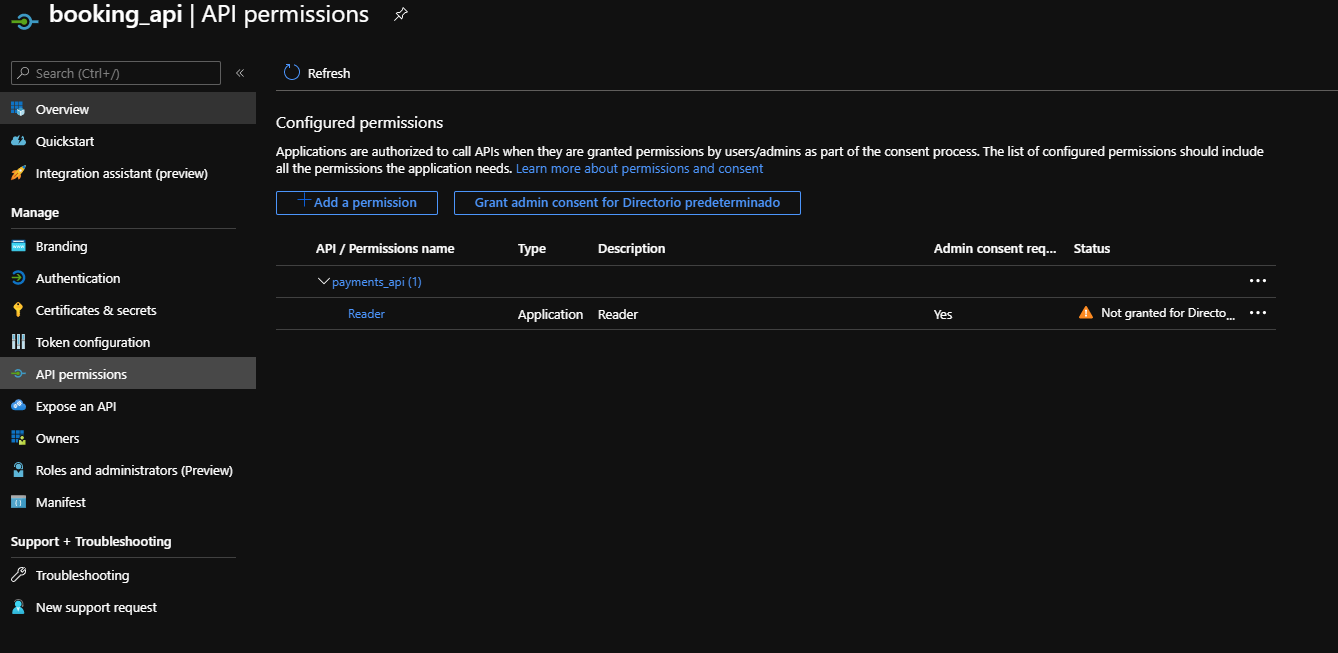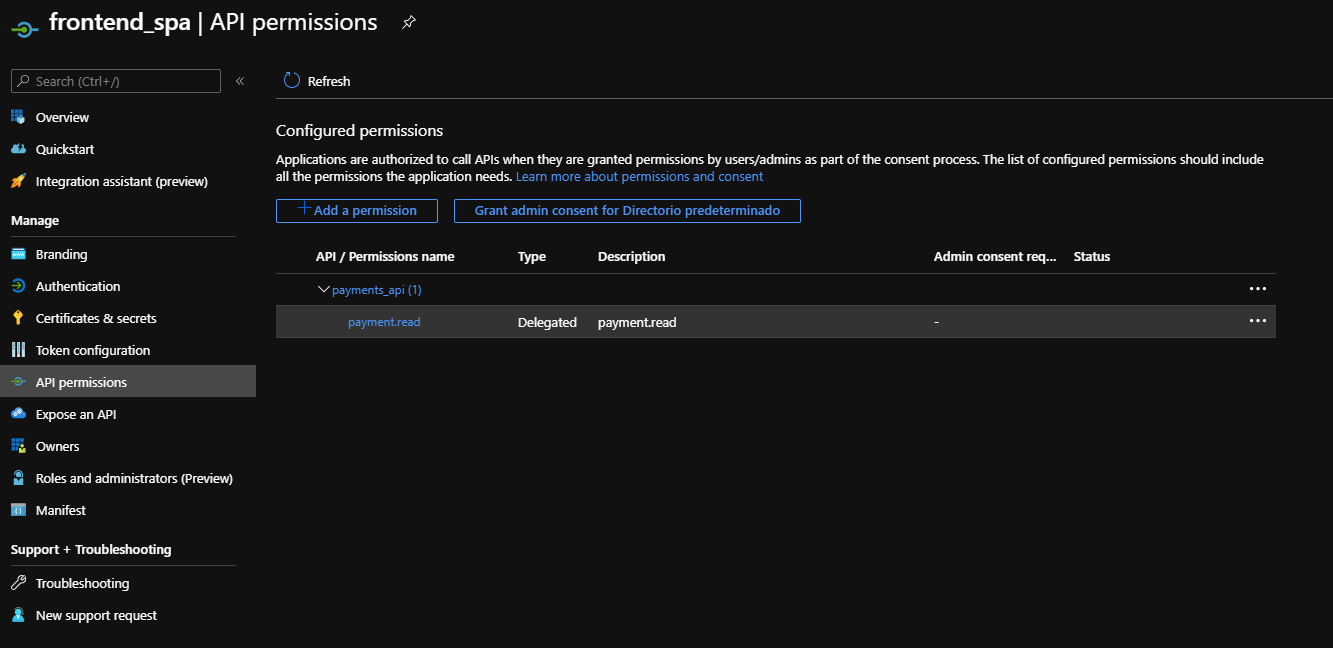Trying to automate Azure Active Directory App Registration process using Terraform
Update (11/29/2023) : This post has been deprecated. If you want to read a more recent one, click here.
Today I want to try to use Terraform to automate the app registration process in Azure Active Directory.
If you want to secure an application Azure Active Directory is a really good option, but I don’t want to configure my application on AAD manually, what I really want is to add a step in my CI / CD pipeline that does that for me, and for that purpose Terraform might be a good option.
Terraform already has an official Azure Active Directory provider written by Microsoft itself (https://www.terraform.io/docs/providers/azuread/index.html), so in today’s post I’m going to focus on trying it out.
I’m going to build a pretty common and straightforward scenario using the Terraform provider. The scenario is the following one:
-
Payment API: That’s going to be our resource server.
- It exposes 2 scopes : payment.write and payment.read
- It has 2 application roles: Reader and Admin
-
Booking API:
- Consumes the Payment API using a Client Credentials flow.
- Obtains an access_token from the AAD token endpoint and uses it to attain access to the Payment API.
- It has the Payment API Reader Role assigned.
- Consumes the Payment API using a Client Credentials flow.
-
FrontEnd SPA:
- It’s a “Single Page Application” written in some crazy Javascript framework.
- Uses an implicit flow to obtain an access_token and id_token and uses the access_token to attain access to the Payment API.
- The FrontEnd SPA app has permission only to ask for the payment.read scope.
- It’s a “Single Page Application” written in some crazy Javascript framework.
-
Users:
- I have created 2 users in my AAD: John and Jane
- Jane has assigned a Reader role in the Payment API app
- John has assigned an Admin role in the Payment API app
- I have created 2 users in my AAD: John and Jane
Let’s start building it, I need to register 3 apps. But first of all I need to configure the azuread provider.
Step 1: Configure the Azure AD provider
The first step is to configure the AzureAD Provider.
To authenticate against my AAD I’m going to create a new Application and a Service Principal with a client secret.
There are other options available to authenticate against the AAD using the provider, you can read it here: https://www.terraform.io/docs/providers/azuread/guides/service_principal_client_secret.html
Basically what I’m going to do is create a “master app” in my AAD, a “master app” is nothing more than an app with permissions to create another apps. Here is a detailed walkthrough about how to do it: https://www.terraform.io/docs/providers/azuread/guides/service_principal_configuration.html
The first weird thing that you’re going to find while creating the “master app” is the fact that the provider uses the Legacy Azure Active Directory API (Azure Active Directory Graph) instead of the newer MS Graph API.
That’s a bad sign to begin with, it means that all the most recent features probably are not doable with the provider.
But let’s going forward, that’s the final look after registering in my AAD the master app and giving it the proper permissions:

Now we can configure the Terraform provider using the master app client_id and client_secret.
provider "azuread" {
version = "=1.1.1"
client_id = "ba4d0620-0522-4ada-b0b6-0cdd8cfaeae7"
client_secret = "my_secret_goes_here"
tenant_id = "my_tenant_goes_here"
}
Step 2: Register the payment API
Next step is to create the payment API using Terraform. The payment API has the following configuration:
- It exposes 2 scopes : payment.write and payment.read.
- It has 2 application roles: Reader and Writer.
resource "azuread_application" "payments_api" {
name = "payments_api"
available_to_other_tenants = false
oauth2_allow_implicit_flow = false
type = "webapp/api"
identifier_uris = ["api://payment"]
}
resource "azuread_application_oauth2_permission" "payment_apis_payment_write_scope" {
application_object_id = azuread_application.payments_api.id
admin_consent_description = "Allow the application to access the commit payment methods"
admin_consent_display_name = "payment.write"
is_enabled = true
type = "Admin"
value = "payment.write"
user_consent_description = "Allow the application to access the commit payment methods"
user_consent_display_name = "payment.write"
}
resource "azuread_application_oauth2_permission" "payment_apis_payment_read_scope" {
application_object_id = azuread_application.payments_api.id
admin_consent_description = "Allow the application to access the read payment methods"
admin_consent_display_name = "payment.read"
is_enabled = true
type = "User"
value = "payment.read"
user_consent_description = "Allow the application to access the read payment methods"
user_consent_display_name = "payment.read"
}
resource "azuread_application_app_role" "payments_api_admin_approle" {
application_object_id = azuread_application.payments_api.id
allowed_member_types = ["User", "Application"]
description = "Can read and make payments"
display_name = "Admin"
is_enabled = true
value = "Admin"
}
resource "azuread_application_app_role" "payments_api_reader_approle" {
application_object_id = azuread_application.payments_api.id
allowed_member_types = ["User", "Application"]
description = "Can only read payments"
display_name = "Reader"
is_enabled = true
value = "Reader"
}
resource "azuread_service_principal" "payment_sp" {
application_id = azuread_application.payments_api.application_id
app_role_assignment_required = false
tags = [ "payment", "api"]
}
It’s a pretty straightforward config file but I have encountered some issues while building it.
The first issue:
- I can create the application roles but there is NO way to assign users or groups to those roles.
Poking around their Github (https://github.com/terraform-providers/terraform-provider-azuread) I found that it’s an already known issue ( https://github.com/terraform-providers/terraform-provider-azuread/issues/230) and it seems that the issue is because the provider is using the legacy AAD api and the user/group role assignments can only be accomplished through the Microsoft Graph API.
Exists some workarounds like using the shell-provider or the local-exec provider to assign users to a role.
There is an example on this page: https://github.com/terraform-providers/terraform-provider-azuread/issues/164
Or you can do it manually… go into the “enterprise applications” blade in the portal, select the payment app and assign users and groups.
The second issue I found is:
- Not all the manifest attributes are present.
For example, I like to change the “accessTokenAcceptedVersion” attribute so the token endpoint only generates tokens in the V2 format (I will talk about that nonsensical behaviour in a future post…) but I cannot do it with the provider, I have to change it manually again..
Step 3: Register the Booking API
The Booking API has the following configuration:
- Consumes the Payment API using a Client Credentials flow.
- Obtains an access_token from AAD and uses it to attain access to the Payment API.
- The Booking API has the Payment API Reader Role assigned.
resource "azuread_application" "booking_api" {
name = "booking_api"
available_to_other_tenants = false
oauth2_allow_implicit_flow = false
type = "webapp/api"
identifier_uris = ["api://booking"]
required_resource_access {
resource_app_id = azuread_application.payments_api.application_id
resource_access {
id = azuread_application_app_role.payments_api_reader_approle.role_id
type = "Role"
}
}
}
resource "azuread_service_principal" "booking_sp" {
application_id = azuread_application.booking_api.application_id
app_role_assignment_required = false
tags = [ "payment", "api"]
}
resource "azuread_application_password" "booking_api_pwd" {
application_object_id = azuread_application.booking_api.id
description = "My managed password"
value = "VT=uSgbTanZhyz@%nL9Hpd+Tfay_MRV#"
end_date = "2099-01-01T01:02:03Z"
}
Apart from creating the application I’m also creating a client secret to test the client credentials flow.
Be mindful that the Terraform provider cannot grant consent to use the role in an automatically way, you need to do it manually or using a script.

After doing that, let’s test it and see if it works. I’m going to request an access token using the Booking API client id and client secret.
curl -X POST \
https://login.microsoftonline.com/8a0671e2-3a30-4d30-9cb9-ad709b9c744a/oauth2/v2.0/token \
-H 'Cache-Control: no-cache' \
-H 'Content-Type: application/x-www-form-urlencoded' \
-d 'grant_type=client_credentials&client_id=5cd49945-086c-4605-9f86-00fe08134dab&client_secret=VT%3DuSgbTanZhyz%40%25nL9Hpd%2BTfay_MRV%23&scope=api%3A%2F%2Fpayment%2F.default'
And it returns an access_token with the following attributes:
{
"aud": "api://payment",
"iss": "https://sts.windows.net/8a0671e2-3a30-4d30-9cb9-ad709b9c744a/",
"iat": 1595422827,
"nbf": 1595422827,
"exp": 1595426727,
"aio": "E2BgYGAtTs258t5NtmeuveDN2979AA==",
"appid": "5cd49945-086c-4605-9f86-00fe08134dab",
"appidacr": "1",
"idp": "https://sts.windows.net/8a0671e2-3a30-4d30-9cb9-ad709b9c744a/",
"oid": "3b78fe9b-7641-4a73-9b0c-bd05383a27bc",
"rh": "0.AR8A4nEGijA6ME2cua1wm5x0SkWZ1FxsCAVGn4YA_ggTTasfALk.",
"roles": [
"Reader"
],
"sub": "3b78fe9b-7641-4a73-9b0c-bd05383a27bc",
"tid": "8a0671e2-3a30-4d30-9cb9-ad709b9c744a",
"uti": "41oex9rUzU28oibY_D0hAA",
"ver": "1.0"
}
So far so good, the issuer and the audience are both correct and it also contains the Reader application Role.
Step 4: Register the FrontEnd SPA
The FrontEnd SPA has the following configuration:
- It’s a public “Single Page Application” written in Angular.
- Uses an implicit flow to obtain an access token and a id token and aftewards uses the access token to attain access to the Payment API.
- The FrontEnd SPA app has permission only to ask for the payment.read scope.
resource "azuread_application" "frontend_spa" {
name = "frontend_spa"
available_to_other_tenants = false
oauth2_allow_implicit_flow = true
reply_urls = ["https://oidcdebugger.com/debug"]
logout_url = "https://localhost:4200/logout"
required_resource_access {
resource_app_id = azuread_application.payments_api.application_id
resource_access {
id = azuread_application_oauth2_permission.payment_apis_payment_read_scope.permission_id
type = "Scope"
}
}
}
resource "azuread_service_principal" "frontend_spa" {
application_id = azuread_application.frontend_spa.application_id
app_role_assignment_required = false
tags = [ "frontend", "spa"]
}
I have found a few problems with the SPA:
- I have the same issue I mention in the step 3: the Terraform provider cannot grant admin content to use the payment API scope in a programmatic way.

-
You can specify that the application type is “SPA” and use the grant type auth code flow with PKCE if you register the app using the portal, but that option is missing here. So I’m being forced to instead use an implicit flow.
Again the problem is that the provider is not using the MS Graph API, it seems that I’m not the only one with the same problem: https://github.com/terraform-providers/terraform-provider-azuread/issues/286 -
There is also a weird infinite loop if you set the public_client to true. Every time you run the “terraform plan” command it detects a drift and changes your application type from “native” to “webapp/api”.
Seems that again I’m not the only one experiencing this problem: https://github.com/terraform-providers/terraform-provider-azuread/issues/236
Those issues should not affect us, let’s test it. I’m starting an implicit flow and try to log in as Jane.
Remember from the step 2 that I have manually assigned a Reader role in the Payment API to Jane.
The fastest way to begin an implicit flow is by building the URI by myself.
https://login.microsoftonline.com/8a0671e2-3a30-4d30-9cb9-ad709b9c744a/oauth2/v2.0/authorize
?client_id=c6b731f2-785b-4206-974a-db8d34eb4397
&redirect_uri=https%3A%2F%2Foidcdebugger.com%2Fdebug
&scope=api%3A%2F%2Fpayment%2Fpayment.read%20openid
&response_type=token%20id_token
&response_mode=form_post
&nonce=iaiqs1h3pa
And it returns an access_token with the following attributes:
{
"aud": "api://payment",
"iss": "https://sts.windows.net/8a0671e2-3a30-4d30-9cb9-ad709b9c744a/",
"iat": 1595425611,
"nbf": 1595425611,
"exp": 1595429511,
"acr": "1",
"aio": "ATQAy/8QAAAAOe3HCSYBGo663Mt+8XSEK/yY+P8Ao4qLGurtTMz5S9VtG7FBYdfpCiPb3qP59gHO",
"amr": [
"pwd"
],
"appid": "c6b731f2-785b-4206-974a-db8d34eb4397",
"appidacr": "0",
"given_name": "doe",
"ipaddr": "00.00.000.0",
"name": "jane",
"oid": "0a92ffc5-9551-47a0-baf0-7f3352eac015",
"rh": "0.AR8A4nEGijA6ME2cua1wm5x0SvIxt8ZbeAZCl0rbjTTrQ5cfAAc.",
"roles": [
"Reader"
],
"scp": "payment.read",
"sub": "ODPx3tnkeekXKN1Olvx8pD5e5PcXJMCg0LoaHz3F14g",
"tid": "8a0671e2-3a30-4d30-9cb9-ad709b9c744a",
"unique_name": "jane@cpnoutlook.onmicrosoft.com",
"upn": "jane@cpnoutlook.onmicrosoft.com",
"uti": "wYVNdVa5Bk6FE7iZjNkjAA",
"ver": "1.0"
}
Everything looks alright: issuer, audience, scopes, upn, roles.
Conclusion
It is really easy to built a pretty common scenario using the AAD Terraform provider and if you already have some knowledge about how AAD works it’s going to be a breeze switching from the portal to Terraform.
But be aware that the provider STILL is lacking features, just tinkering with the provider for a very brief period of time I have already found some missing features:
- You cannot assign users or groups into an app.
- You cannot grant admin consent programatically.
- It’s missing the grant type auth code flow with PKCE.
All those issues can be resolved is you’re willing to mix the AAD provider with another provider like the shell-provider or if you build some scripts that fills in for those missing steps.
I’m also surprised that the provider is still using the Legacy Azure Active Directory API (Azure Active Directory Graph) instead of the newer MS Graph API, that raises some doubts about the adoption of the new features that are only possible using the newer Graph API, so be aware of it.
Updated Conclusion:
The version 1.1.1 still is burdened by the use of the legacy AAD API.
So all the more recent features that where missing on the 0.11 release are still missing in this version.
The good news is that it seems that they’re already working on a new version that uses the MS Graph Api. More info here: https://github.com/terraform-providers/terraform-provider-azuread/issues/323
Apart from that, there are not a lot of new things to comment to. It is nice that now we can create appRoles and OAuth2 permissions outside of the application resource, but to be honest after testing the 1.1.1 version I didn’t find any major improvements compared to the 0.11.